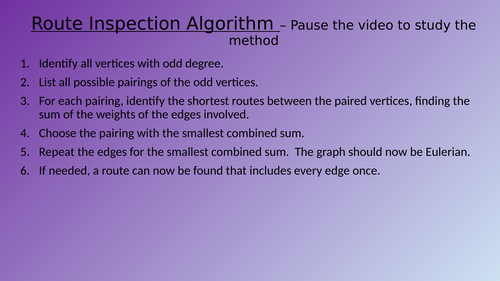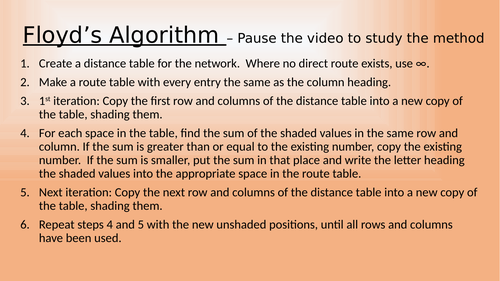42Uploads
63k+Views
2k+Downloads
Mathematics

Big M Method for Simplex Algorithm (PowerPoint)
This PowerPoint will guide you through an example of using the Big M Method for solving simplex algorithm problems with “greater than or equals to” constraints.
There is a video of the PowerPoint being used available at the link below.
https://youtu.be/grGWsUHdWQM

Simplex Algorithm - Integer Solutions powerpoint
This powerpoint will go through the main points when dealing with an integer solution constrained simplex algorithm problem.
A video of the powerpoint in use can be found at the address below:
https://youtu.be/tsXlclDkzuA

The Simplex Algorithm - PowerPoint
This PowerPoint will guide you through the application of The Simplex Algorithm, as featured in the Edexcel Further Maths Decision course. The PowerPoint covers both Maximising and Minimising problems.
There is a video demonstrating the use of this PowerPoint available at the link below:
https://youtu.be/t0NkCDigq88

The Order of an Algorithm
A brief 2-slide powerpoint illustrating the order of algorithms. For use in Decision Maths.

Dijkstra's Algorithm
A PowerPoint demonstrating the use of Dijkstra’s Algorithm. A video showing the use of the presentation can be found at the address below:
https://youtu.be/tgp9I_K_WqU

Prim's Algorithm (Matrix Method)
A PowerPoint demonstrating the use of the matrix method for Prim’s Algorithm. A video demonstrating the use of the PowerPoint can be found at the address below:
https://youtu.be/lebeO26FuMk

Prim's Algorithm
A PowerPoint demonstrating the application of Prim’s Algorithm. A video showing the presentation in use can be found at the address below:
https://youtu.be/kUmi5QKH5m8

Kruskal's Algorithm PowerPoint
A presentation showing how to use Kruskal’s Algorithm. A video demonstrating the use of the presentation can be found at the address below:
https://youtu.be/Mrb61iGXUFk

Route Inspection algorithm (Chinese Postman problem)
This PowerPoint provides an example of the Route Inspection algorithm being used. There is a video of the PowerPoint being used available at the address below:
https://youtu.be/958NcfRL4GQ

Floyd's Algorithm
A PowerPoint demonstrating how to use Floyd’s Algorithm for the Decision Maths course. There is a video demonstrating the use of the powerpoint available at the address below:
https://youtu.be/3wmsXtSUm8Y

Simplex Algorithm -Integer Solutions PPT
This is a powerpoint to demonstrate the use of the Simplex Algorithm when integer solutions are called for, and it supplements the other Simplex Algorithm powerpoint that is available on TES too.
There is a video demonstrating the use of this powerpoint available at the link below:
https://youtu.be/ICBrU_wghSs

Travelling Salesman Problem -Lower Bound
The Powerpoint shows how to use the minimum spanning tree method to find a lower bound for the Travelling Salesman Problem. There is a video showing its use available at the address below:
https://youtu.be/VcugXirtWOo

Travelling Salesman Problem -Upper Bound
The Powerpoint shows how to use the minimum spanning tree method to find an upper bound for the Travelling Salesman Problem. There is a video showing its use available at the address below:
https://youtu.be/xN9ZtYzPewg

Nearest Neighbour Upper Bound for Travelling Salesman Problem
This PowerPoint will guide you through the process of finding an upper bound for the Travelling Salesman Problem using the Nearest Neighbour method. This was created with the Edexcel A Level Further Maths course in mind, but it should be suitable for others too.
There is a video of the powerpoint in use at the link below:
https://youtu.be/ojjnd5gEMuk
Bundle

Simplex Algorithm and Variants PowerPoints Bundle
PowerPoint presentations on the Simplex Algorithm, including integer solutions, the Two Stage Method and the Big M Method. Also includes a one sheet version of the algorithm. Videos of all powerpoints included are on the specific resource pages.
Bundle

Travelling Salesman Problem Bounds PowerPoints Bundle
A collection of all three powerpoints for finding bounds on the Travelling Salesman problem, as used in the Further Maths A Level course. Videos of their use are available on each individual resource page.

Finding A Critical Path On An Activity Network PPT
This powerpoint presentation will go through an example of how to find the critical path on an activity network, demonstrating the earliest and latest event times, and the float.
There is a video of the resource being used at the address below:
https://youtu.be/XqVdHW9-0DE

Integrating using different methods - 60 questions
This sheet simply presents 60 different expressions to be integrated. A variety of different methods must be used, such as integration by parts, trigonometric identities and so on, however the questions do not indicate which method must be used in each case.
The bundle includes a sheet of just questions, a sheet of just answers and a document including the questions, answers and worked solutions to each question.
I have found this very useful for students at the end of the A Level Maths course to get them to think about the different methods that they must use and what clues to look for in the questions.

Skills Progress Assessments
This series of assessments is intended to be taken at the start of every term from Year 7 to Year 11. Each assessment tests purely the mathematical skills of the students and tracks their progress over the years via the included spreadsheet. Almost every question is provided without context so that the skills are at the forefront of the assessments.
To use the spreadsheet, enter the names of the students in the first sheet. This will then populate throughout the rest of the sheets. For each test, simply put the score for each question for each student, and everything else is then calculated automatically. The last sheet on the spreadsheet, “Progress Sheet” can then be printed out and given to the students so that they can directly see their progress for each skill. Numerical links to Hegarty Maths tasks are also given.
When printing out sheets for the students, note that it will only print out the results for one student at a time, but it will just give them the coloured progress section. When discussing their work, we don’t make any reference to total mark, or what it is out of as we prefer to just focus on their progress with the skills rather than the students just focusing on their total mark.
Should you wish to make any changes to the spreadsheet, the password is “mouse”.



















